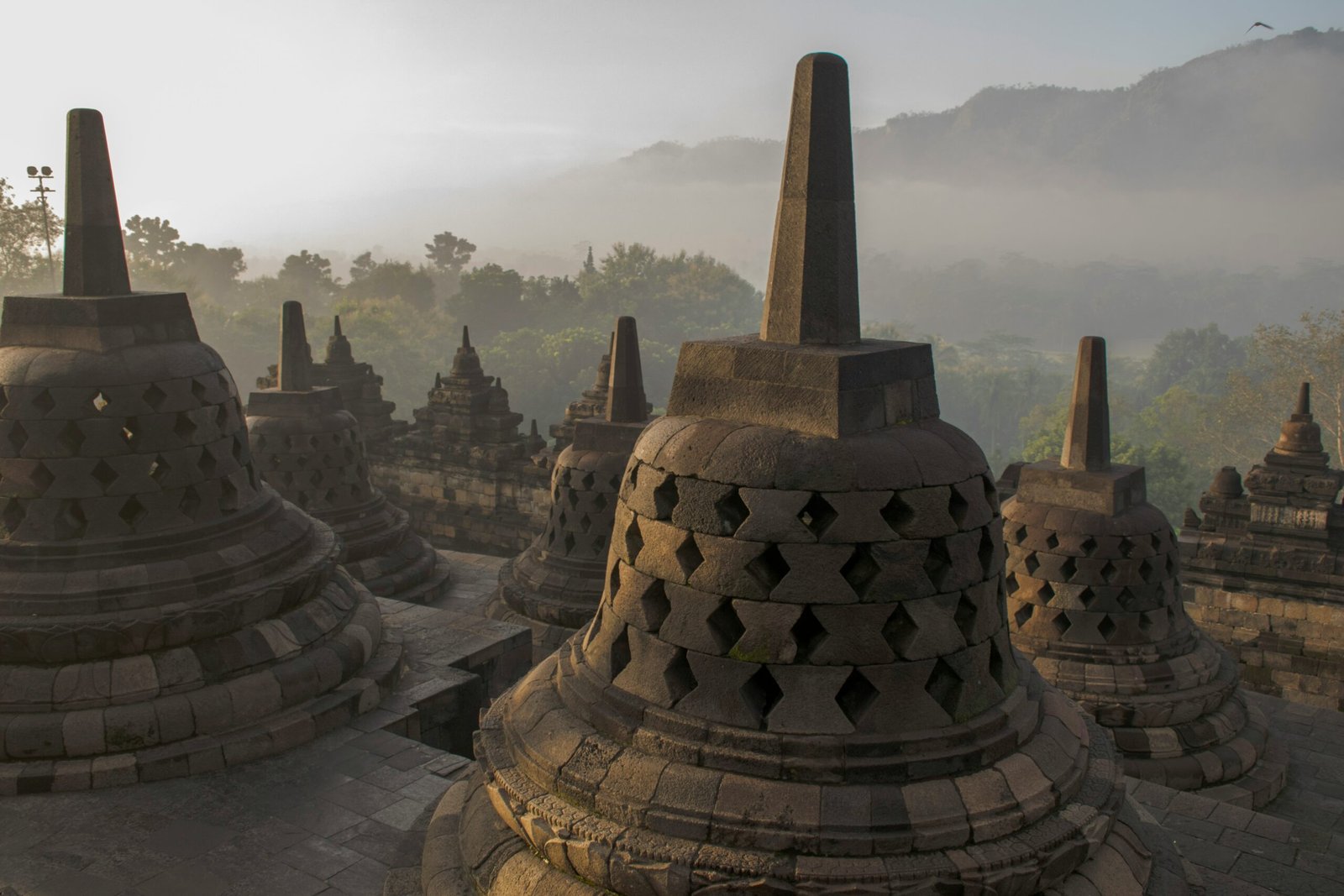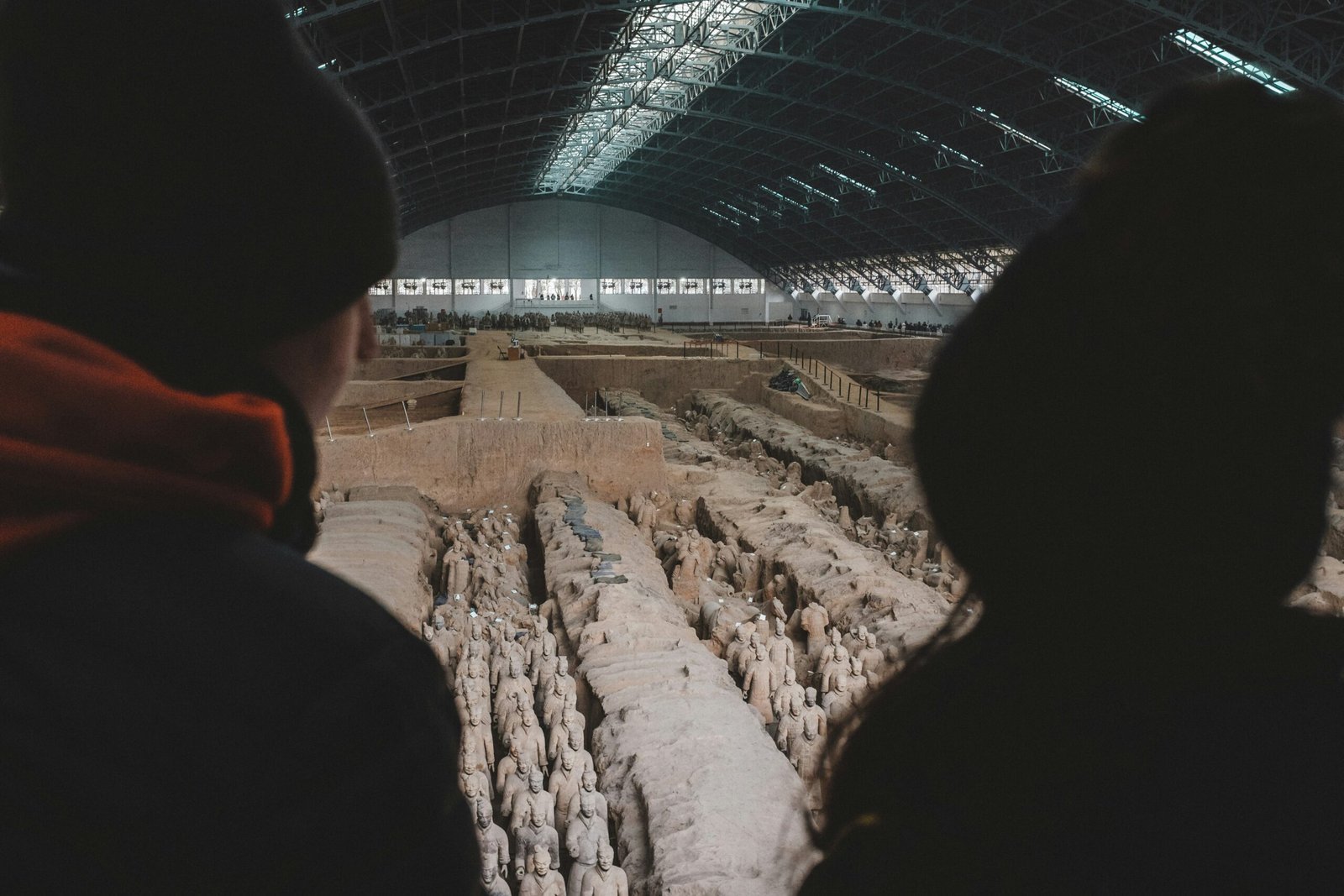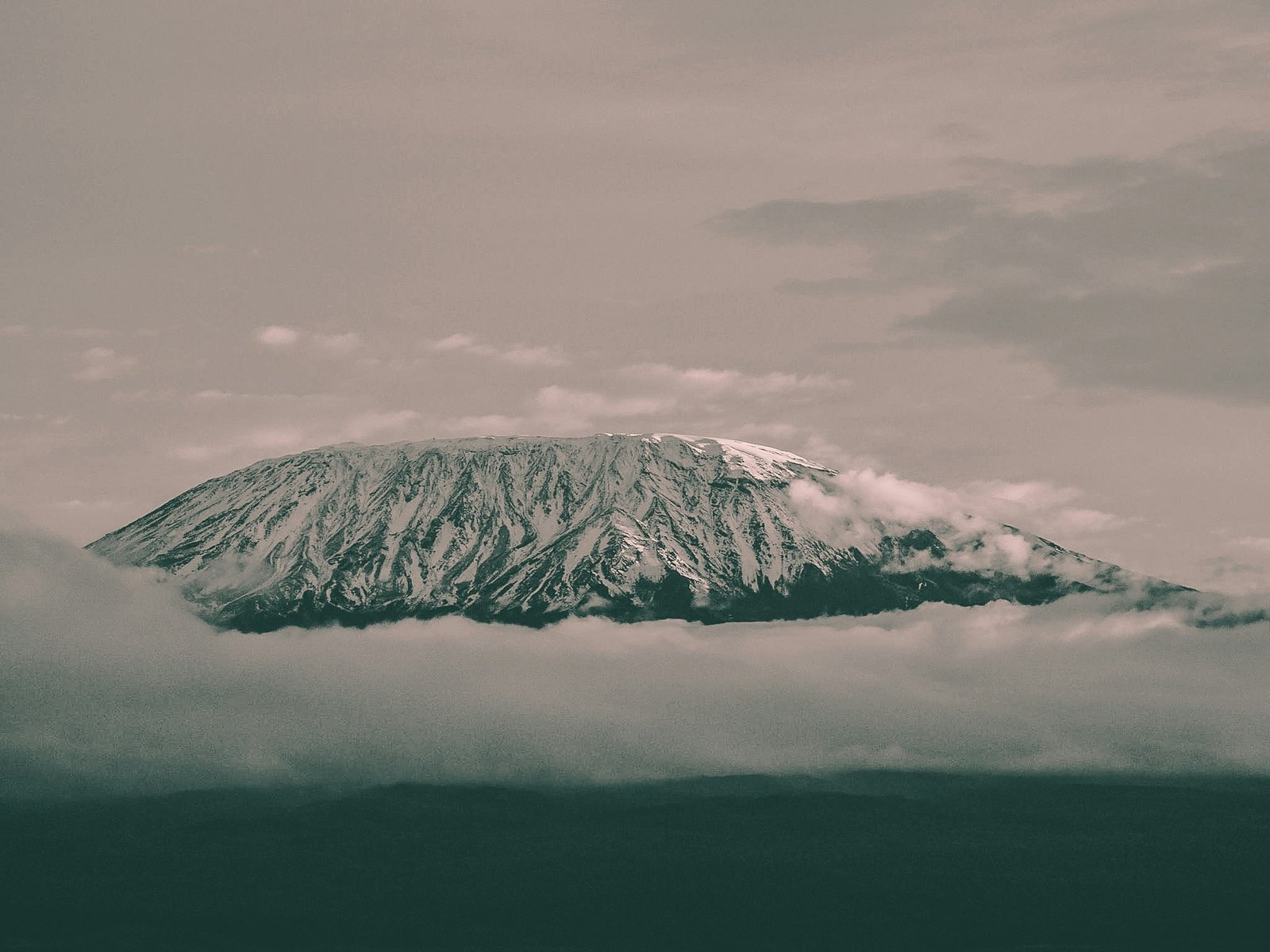
The Borobudur Temple is an architectural masterpiece that dates back to the 9th century. Its construction was commissioned by the Sailendra dynasty, who ruled over Central Java at that time. The temple was built in the shape of a mandala, representing the universe in Buddhist cosmology. It consists of nine stacked platforms, with a central dome at the top, adorned with intricate carvings and statues.
One of the most fascinating aspects of Borobudur is its sheer size. The temple covers an area of approximately 2,500 square meters and reaches a height of 35 meters. It is made entirely of volcanic stone, and the meticulous craftsmanship that went into its construction is evident in every detail. Each stone block was carefully carved and fitted together without the use of any mortar, making the temple a true engineering marvel.
As visitors approach the temple, they are greeted by a series of terraces adorned with bas-reliefs. These reliefs depict scenes from Buddhist teachings and Javanese folklore, offering a glimpse into the history and culture of the region. The reliefs also serve as a visual narrative of the path to enlightenment, guiding pilgrims as they ascend the temple.
At the top of the temple, visitors are rewarded with a breathtaking panoramic view of the surrounding landscape. The temple is strategically positioned on a hill, overlooking lush green valleys and distant mountains. It is said that the view from the top symbolizes the journey to enlightenment, with the temple representing the steps one must take to reach spiritual awakening.
Borobudur is not only a place of worship but also a site of pilgrimage for Buddhists from all over the world. Every year, thousands of devotees gather at the temple to celebrate Vesak, a major Buddhist festival that commemorates the birth, enlightenment, and death of Gautama Buddha. During this festival, the temple is adorned with colorful decorations, and a procession takes place, attracting visitors and locals alike.
Visiting Borobudur is an unforgettable experience that offers a glimpse into the rich history and cultural heritage of Indonesia. The temple’s grandeur and spiritual significance make it a must-visit destination for anyone traveling to Java. Whether you are a history enthusiast, a spiritual seeker, or simply a lover of architecture, Borobudur will leave you in awe of its beauty and timeless appeal.
The Borobudur Temple is not only an architectural masterpiece but also a testament to the rich history and cultural heritage of Indonesia. The Sailendra dynasty, which ruled Java during the 8th and 9th centuries, commissioned the construction of this magnificent temple. The Sailendras were devout Buddhists, and the temple was built as a place of worship and pilgrimage for followers of the religion.
The construction of the Borobudur Temple began around 780 AD under the patronage of King Samaratungga, a ruler of the Sailendra dynasty. It was a massive undertaking that involved thousands of workers and took approximately 75 years to complete. The temple was constructed using millions of volcanic stones, which were meticulously carved and arranged to form intricate reliefs and statues.
Once completed, the Borobudur Temple stood as the largest Buddhist temple in the world. Its design reflects the Mahayana Buddhist cosmology, with its nine stacked platforms representing the stages of spiritual enlightenment. The temple is adorned with over 2,600 relief panels and 500 Buddha statues, each meticulously crafted to depict scenes from Buddhist scriptures and teachings.
Despite its grandeur, the Borobudur Temple was not destined to stand the test of time. In the centuries that followed its construction, the temple fell into disrepair and was eventually abandoned. It was buried under layers of volcanic ash from the eruption of Mount Merapi and was swallowed by the dense jungle that had grown around it.
It wasn’t until the early 19th century that the Borobudur Temple was rediscovered by Sir Thomas Stamford Raffles, the British ruler of Java. Raffles, who had a keen interest in archaeology and history, heard rumors of a magnificent temple hidden in the jungles of Central Java. Intrigued, he set out on an expedition to find it.
After days of trekking through thick vegetation and navigating treacherous terrain, Raffles and his team stumbled upon the hidden treasure. The sight that greeted them was awe-inspiring – a colossal temple rising from the jungle, its intricate carvings and towering stupas a testament to the skill and craftsmanship of its builders.
Since its rediscovery, extensive restoration efforts have been undertaken to preserve and showcase the Borobudur Temple. The temple has been meticulously restored, with damaged stones replaced and missing statues recreated. Today, it stands as one of the most important cultural and religious sites in Indonesia, attracting millions of visitors from around the world.
Architectural Marvel
The Borobudur Temple is an architectural marvel, consisting of nine stacked platforms, six square and three circular, topped by a central dome. The entire structure is adorned with intricate carvings and sculptures, depicting scenes from Buddhist teachings and Javanese culture.
The temple’s design is based on the Buddhist concept of the universe. The bottom level represents the earthly realm, while the top level symbolizes nirvana. Visitors can climb the temple’s terraces, following a path that spirals around the monument, leading them closer to enlightenment.
As visitors ascend the temple, they are enveloped in a sense of tranquility and awe. The carvings on the walls tell stories of the Buddha’s life and teachings, capturing the essence of Buddhism in stone. Each panel is meticulously crafted, with intricate details that showcase the skill and artistry of the craftsmen who built the temple.
One of the most striking features of Borobudur is the central dome, which is surrounded by smaller stupas. These stupas house statues of the Buddha, each one unique in its pose and expression. The sight of these statues, standing tall and serene, is a powerful reminder of the spiritual journey that the temple represents.
From the top of Borobudur, visitors are rewarded with breathtaking views of the surrounding landscape. The temple is situated on a hill, overlooking lush green fields and distant mountains. The beauty of the natural surroundings adds another layer of significance to the temple, creating a harmonious blend of nature and spirituality.
Throughout the centuries, Borobudur has stood as a testament to the ingenuity and creativity of the ancient Javanese civilization. Its construction required immense skill and dedication, as thousands of workers labored to bring the vision to life. The result is a masterpiece that continues to inspire and captivate visitors from around the world.
Spiritual Significance
The Borobudur Temple holds immense spiritual significance for Buddhists around the world. It is believed to be a place of enlightenment and a path to reach nirvana. Pilgrims from various Buddhist traditions visit the temple to meditate, pray, and perform religious rituals.
One of the most significant rituals at Borobudur is the Waisak ceremony, which commemorates the birth, enlightenment, and death of Gautama Buddha. During this ceremony, thousands of Buddhist monks and devotees gather at the temple to chant, meditate, and release lanterns into the night sky.
The Waisak ceremony is a vibrant and deeply spiritual event that attracts Buddhists from all over the world. The ceremony usually takes place during the full moon in May, and it is considered one of the most important Buddhist festivals. The atmosphere at Borobudur during this time is truly magical, with the temple illuminated by the soft glow of lanterns and the sound of chanting filling the air.
The ceremony begins with a procession led by Buddhist monks, who carry sacred relics and statues of the Buddha. The devotees follow behind, dressed in white robes and carrying offerings of flowers and incense. As they make their way through the temple complex, they stop at various points to pray and meditate.
At the main stupa, which is located at the top of the temple, a special ceremony takes place. Buddhist monks lead the crowd in chanting and meditation, creating a sense of peace and tranquility. As the sun sets, the atmosphere becomes even more serene, and the devotees release lanterns into the night sky as a symbol of enlightenment and liberation.
For many Buddhists, participating in the Waisak ceremony at Borobudur is a deeply personal and transformative experience. It is a time for reflection, self-discovery, and spiritual renewal. The temple itself is seen as a sacred space, a place where one can connect with the divine and find inner peace.
In addition to the Waisak ceremony, Borobudur also hosts other important Buddhist events throughout the year. These include Vesak, which celebrates the birth, enlightenment, and death of the Buddha, as well as various meditation retreats and teachings by renowned Buddhist teachers.
Overall, the Borobudur Temple is not just a historical and architectural marvel, but also a place of profound spiritual significance. It is a testament to the enduring power of Buddhism and a symbol of the quest for enlightenment. Whether one is a devout Buddhist or simply a curious traveler, a visit to Borobudur is sure to leave a lasting impression and a deep sense of awe and wonder.
After exploring the main temple, you can also take the time to explore the surrounding smaller temples and shrines that make up the Borobudur complex. These structures are equally fascinating and offer a glimpse into the rich history and culture of the region.
One of the highlights of a visit to Borobudur is the opportunity to witness a sunrise or sunset from the temple. The temple’s elevated position provides a breathtaking view of the surrounding landscape, with the sun casting a golden glow over the entire area. It’s a truly magical experience that shouldn’t be missed.
For those interested in delving deeper into the spiritual significance of Borobudur, there are meditation retreats and workshops available. These programs allow visitors to learn and practice meditation in the serene and peaceful surroundings of the temple. It’s a unique opportunity to connect with oneself and gain a deeper understanding of Buddhist teachings.
Aside from the temple itself, the surrounding area offers plenty of other attractions to explore. The nearby villages are known for their traditional crafts, such as batik making and silver jewelry. You can also visit local markets to sample delicious Indonesian cuisine and buy unique souvenirs.
If you have more time, consider taking a day trip to the nearby Prambanan Temple, another UNESCO World Heritage Site. This Hindu temple complex is equally impressive and showcases the rich cultural diversity of Indonesia.
Overall, a visit to Borobudur is a journey of discovery, spirituality, and cultural immersion. It’s a place where ancient history and modern-day life seamlessly blend, offering visitors a truly unforgettable experience.
Preservation Efforts
Preserving the Borobudur Temple is an ongoing effort. The monument faces several challenges, including weathering, erosion, and the impact of tourism. To ensure its longevity, the Indonesian government, along with UNESCO and other international organizations, has implemented various conservation measures.
Regular maintenance, including cleaning, restoration of damaged structures, and monitoring of the site’s stability, is carried out by a team of experts. Visitors are also encouraged to follow guidelines to minimize their impact on the temple and its surroundings.
In addition to these measures, the Indonesian government has established a comprehensive management plan for the Borobudur Temple. This plan includes the establishment of a dedicated conservation team that is responsible for the day-to-day management and preservation of the site. The team consists of archaeologists, historians, architects, and other experts who work together to ensure that the temple remains in good condition.
One of the key aspects of the management plan is the regular monitoring of the temple’s condition. This involves conducting detailed inspections to identify any signs of deterioration or damage. The team uses advanced techniques such as laser scanning and aerial photography to assess the structural integrity of the temple. This information is then used to develop targeted conservation strategies to address any issues that may arise.
To protect the temple from the effects of weathering and erosion, the conservation team has implemented a range of measures. These include the application of protective coatings on the temple’s surfaces, the installation of drainage systems to prevent water accumulation, and the use of appropriate landscaping techniques to minimize soil erosion. Additionally, the team regularly monitors the surrounding vegetation to ensure that it does not pose a threat to the temple’s stability.
Tourism is another major factor that poses challenges to the preservation of the Borobudur Temple. The increasing number of visitors to the site can lead to increased wear and tear on the structures and the surrounding environment. To address this issue, the Indonesian government has implemented a number of measures to manage tourism at the temple.
One such measure is the implementation of a visitor management system. This system includes the introduction of ticketing and entry restrictions to control the number of visitors at any given time. Additionally, the government has established visitor guidelines that outline the expected behavior and conduct when visiting the temple. These guidelines include instructions to avoid touching the temple’s surfaces, not littering, and respecting the religious significance of the site.
To further enhance the visitor experience and minimize the impact on the temple, the government has also developed an educational program. This program aims to raise awareness among visitors about the historical and cultural significance of the Borobudur Temple. Through guided tours, information boards, and interactive exhibits, visitors are provided with a deeper understanding of the temple’s history and the importance of its preservation.
In conclusion, the preservation efforts for the Borobudur Temple involve a comprehensive approach that addresses the challenges of weathering, erosion, and tourism. Through regular maintenance, advanced monitoring techniques, and visitor management strategies, the Indonesian government is committed to ensuring the longevity of this iconic monument. By implementing these measures, the Borobudur Temple can continue to inspire awe and admiration for generations to come.
Visiting Tips
Here are a few tips to make the most of your visit to the Borobudur Temple:
- Plan your visit during the early morning or late afternoon to avoid the crowds and experience the temple in the best light.
- Wear comfortable shoes, as you’ll be climbing steep steps and walking on uneven surfaces.
- Carry a hat, sunscreen, and water, as the temple complex can get hot and humid.
- Respect the temple’s sacredness by dressing modestly and refraining from loud noises or disruptive behavior.
- Take your time to explore the temple at a leisurely pace and soak in its spiritual ambiance.
- Engage with a knowledgeable guide who can provide you with insights into the history, architecture, and symbolism of the temple.
- Bring a camera or a sketchbook to capture the intricate carvings and breathtaking views from the top of the temple.
- Consider attending a sunrise or sunset tour for a truly magical experience as the sun casts a golden glow over the temple.
- Don’t forget to visit the museum located near the temple, which houses a collection of artifacts and exhibits related to Borobudur’s history.
- Support the local community by purchasing souvenirs or handicrafts from the vendors outside the temple complex.
- Take a moment to meditate or reflect in one of the quiet corners of the temple, allowing yourself to connect with the spirituality of the place.
By following these tips, you’ll be able to fully immerse yourself in the beauty and serenity of Borobudur Temple, creating memories that will last a lifetime.



